Analyzing US Action in Afghanistan Under International Law on Defense
VerifiedAdded on 2023/06/17
|6
|1152
|392
Report
AI Summary
This report examines whether the US-led forces' fighting against the Taliban in Afghanistan constitutes anticipatory self-defense under international law. It defines international law as a set of binding norms and principles between nations, referencing treaties, customs, and general legal principles. The analysis centers on Article 51 of the UN Charter and Article 2(4), addressing the right to self-defense against imminent threats, the necessity and proportionality of the response, and the Security Council's role. The report argues that the US action can be viewed as anticipatory self-defense due to the Taliban's role in ongoing threats, which threatened international peace and security. Despite criticisms, the report concludes that the US military action was in line with the UN Charter's provision for self-defense, emphasizing the importance of maintaining international security.
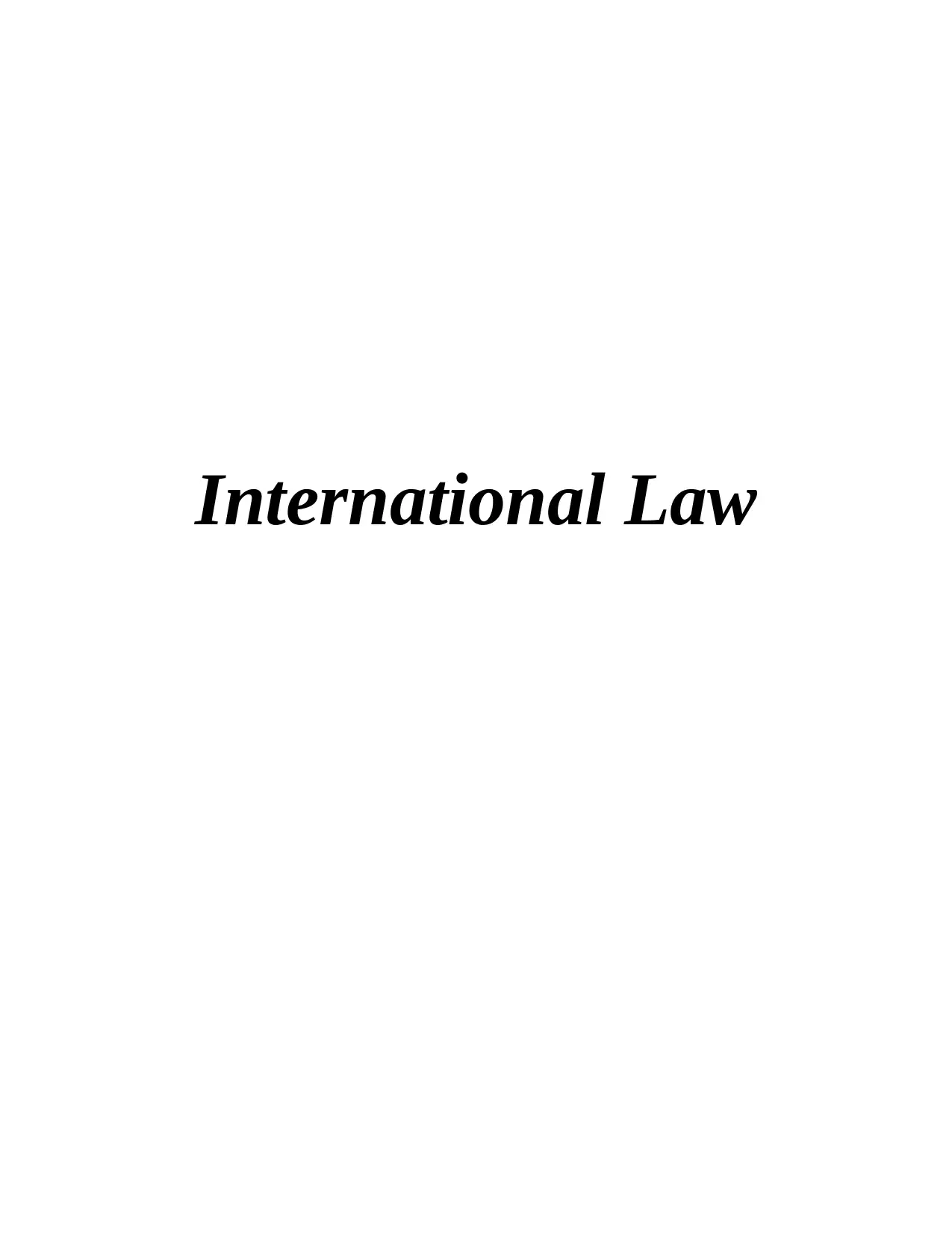
International Law
Paraphrase This Document
Need a fresh take? Get an instant paraphrase of this document with our AI Paraphraser
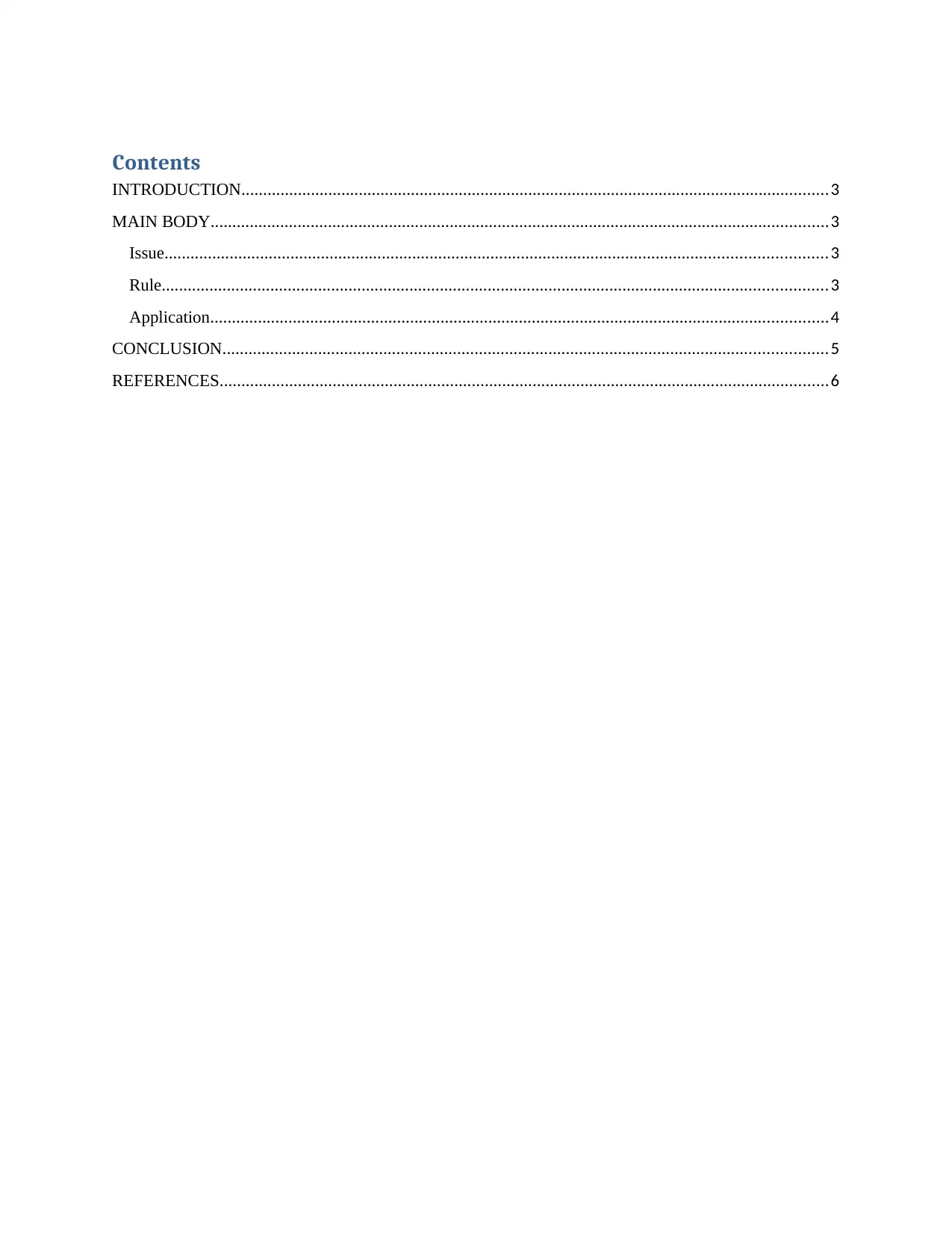
Contents
INTRODUCTION.......................................................................................................................................3
MAIN BODY..............................................................................................................................................3
Issue........................................................................................................................................................3
Rule.........................................................................................................................................................3
Application..............................................................................................................................................4
CONCLUSION...........................................................................................................................................5
REFERENCES............................................................................................................................................6
INTRODUCTION.......................................................................................................................................3
MAIN BODY..............................................................................................................................................3
Issue........................................................................................................................................................3
Rule.........................................................................................................................................................3
Application..............................................................................................................................................4
CONCLUSION...........................................................................................................................................5
REFERENCES............................................................................................................................................6
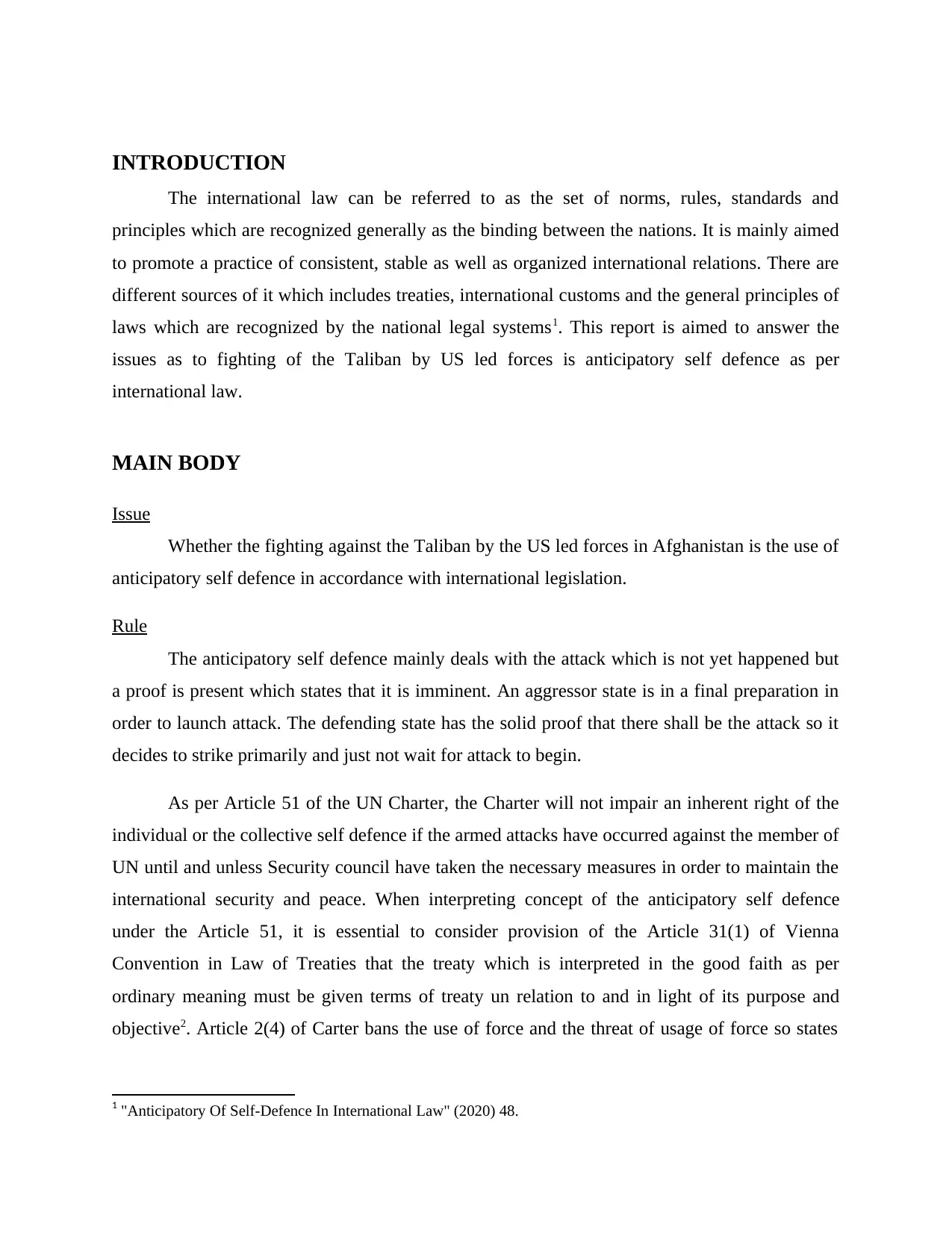
INTRODUCTION
The international law can be referred to as the set of norms, rules, standards and
principles which are recognized generally as the binding between the nations. It is mainly aimed
to promote a practice of consistent, stable as well as organized international relations. There are
different sources of it which includes treaties, international customs and the general principles of
laws which are recognized by the national legal systems1. This report is aimed to answer the
issues as to fighting of the Taliban by US led forces is anticipatory self defence as per
international law.
MAIN BODY
Issue
Whether the fighting against the Taliban by the US led forces in Afghanistan is the use of
anticipatory self defence in accordance with international legislation.
Rule
The anticipatory self defence mainly deals with the attack which is not yet happened but
a proof is present which states that it is imminent. An aggressor state is in a final preparation in
order to launch attack. The defending state has the solid proof that there shall be the attack so it
decides to strike primarily and just not wait for attack to begin.
As per Article 51 of the UN Charter, the Charter will not impair an inherent right of the
individual or the collective self defence if the armed attacks have occurred against the member of
UN until and unless Security council have taken the necessary measures in order to maintain the
international security and peace. When interpreting concept of the anticipatory self defence
under the Article 51, it is essential to consider provision of the Article 31(1) of Vienna
Convention in Law of Treaties that the treaty which is interpreted in the good faith as per
ordinary meaning must be given terms of treaty un relation to and in light of its purpose and
objective2. Article 2(4) of Carter bans the use of force and the threat of usage of force so states
1 "Anticipatory Of Self-Defence In International Law" (2020) 48.
The international law can be referred to as the set of norms, rules, standards and
principles which are recognized generally as the binding between the nations. It is mainly aimed
to promote a practice of consistent, stable as well as organized international relations. There are
different sources of it which includes treaties, international customs and the general principles of
laws which are recognized by the national legal systems1. This report is aimed to answer the
issues as to fighting of the Taliban by US led forces is anticipatory self defence as per
international law.
MAIN BODY
Issue
Whether the fighting against the Taliban by the US led forces in Afghanistan is the use of
anticipatory self defence in accordance with international legislation.
Rule
The anticipatory self defence mainly deals with the attack which is not yet happened but
a proof is present which states that it is imminent. An aggressor state is in a final preparation in
order to launch attack. The defending state has the solid proof that there shall be the attack so it
decides to strike primarily and just not wait for attack to begin.
As per Article 51 of the UN Charter, the Charter will not impair an inherent right of the
individual or the collective self defence if the armed attacks have occurred against the member of
UN until and unless Security council have taken the necessary measures in order to maintain the
international security and peace. When interpreting concept of the anticipatory self defence
under the Article 51, it is essential to consider provision of the Article 31(1) of Vienna
Convention in Law of Treaties that the treaty which is interpreted in the good faith as per
ordinary meaning must be given terms of treaty un relation to and in light of its purpose and
objective2. Article 2(4) of Carter bans the use of force and the threat of usage of force so states
1 "Anticipatory Of Self-Defence In International Law" (2020) 48.
⊘ This is a preview!⊘
Do you want full access?
Subscribe today to unlock all pages.

Trusted by 1+ million students worldwide

have right to defend themselves from any type of threat and also not let it escalate to the actual
use of the force.
The essentials of using this right includes the following-
The capacity of Security Council that state can exercise this right until SC has taken
measures to maintain peace and security internationally.
The state find itself in the position of this right when there is unlawful armed attack or the
unlawful threat of the force by other state.
The necessity test which requires danger of the imminent attack.
Requirement of proportionality which means prevention of attack from occurring such as
there should be necessarily proportionality between conduct which constitute armed force
and opposing conduct.
Last is immediacy which requires immediate use of the right and the attack must consist
of number of successive acts from similar source.
Application
The United States is the member state as well as permanent member of UN so it is bound
by its legal regime. In the military action of US in the Afghanistan, it purported to act in the
constraints which are imposed by UN Charter. There are various elements which are present
when claiming self defence which includes the following-
US have been experiencing the armed attack.
Afghanistan is the perpetrator of that attack (armed).
The armed force shall only be the way to protect against that attack.
There has been no time in order to resort to UN Security Council before beginning armed
attack3.
Self defence is a right to make reaction to imminent threat which is mainly manifest, instant
as well as overwhelming. The reaction made should be proportional as well as necessary. The
deadly force should be used when it is necessary and necessity is needed to make usage of force.
Hence, the right of self defence is mainly to make justification of the lethal force in the action
2 Shah, N. A., "Self-Defence, Anticipatory Self-Defence And Pre-Emption: International Law's Response To
Terrorism" (2017) 12(1) Journal of Conflict and Security Law.
3 Fiedler, Robert, Legitimacy Of Anticipatory Self Defence.
use of the force.
The essentials of using this right includes the following-
The capacity of Security Council that state can exercise this right until SC has taken
measures to maintain peace and security internationally.
The state find itself in the position of this right when there is unlawful armed attack or the
unlawful threat of the force by other state.
The necessity test which requires danger of the imminent attack.
Requirement of proportionality which means prevention of attack from occurring such as
there should be necessarily proportionality between conduct which constitute armed force
and opposing conduct.
Last is immediacy which requires immediate use of the right and the attack must consist
of number of successive acts from similar source.
Application
The United States is the member state as well as permanent member of UN so it is bound
by its legal regime. In the military action of US in the Afghanistan, it purported to act in the
constraints which are imposed by UN Charter. There are various elements which are present
when claiming self defence which includes the following-
US have been experiencing the armed attack.
Afghanistan is the perpetrator of that attack (armed).
The armed force shall only be the way to protect against that attack.
There has been no time in order to resort to UN Security Council before beginning armed
attack3.
Self defence is a right to make reaction to imminent threat which is mainly manifest, instant
as well as overwhelming. The reaction made should be proportional as well as necessary. The
deadly force should be used when it is necessary and necessity is needed to make usage of force.
Hence, the right of self defence is mainly to make justification of the lethal force in the action
2 Shah, N. A., "Self-Defence, Anticipatory Self-Defence And Pre-Emption: International Law's Response To
Terrorism" (2017) 12(1) Journal of Conflict and Security Law.
3 Fiedler, Robert, Legitimacy Of Anticipatory Self Defence.
Paraphrase This Document
Need a fresh take? Get an instant paraphrase of this document with our AI Paraphraser
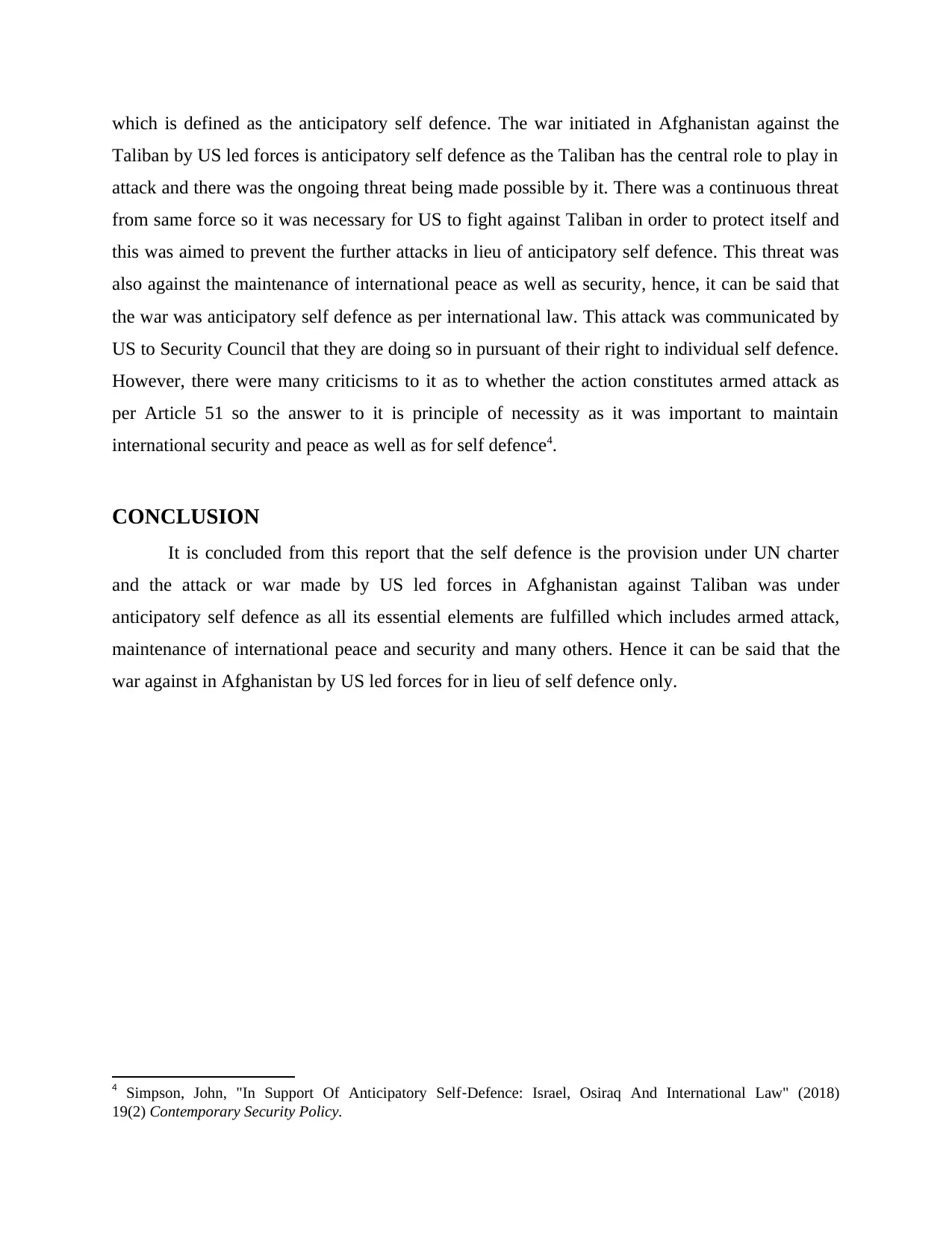
which is defined as the anticipatory self defence. The war initiated in Afghanistan against the
Taliban by US led forces is anticipatory self defence as the Taliban has the central role to play in
attack and there was the ongoing threat being made possible by it. There was a continuous threat
from same force so it was necessary for US to fight against Taliban in order to protect itself and
this was aimed to prevent the further attacks in lieu of anticipatory self defence. This threat was
also against the maintenance of international peace as well as security, hence, it can be said that
the war was anticipatory self defence as per international law. This attack was communicated by
US to Security Council that they are doing so in pursuant of their right to individual self defence.
However, there were many criticisms to it as to whether the action constitutes armed attack as
per Article 51 so the answer to it is principle of necessity as it was important to maintain
international security and peace as well as for self defence4.
CONCLUSION
It is concluded from this report that the self defence is the provision under UN charter
and the attack or war made by US led forces in Afghanistan against Taliban was under
anticipatory self defence as all its essential elements are fulfilled which includes armed attack,
maintenance of international peace and security and many others. Hence it can be said that the
war against in Afghanistan by US led forces for in lieu of self defence only.
4 Simpson, John, "In Support Of Anticipatory Self‐Defence: Israel, Osiraq And International Law" (2018)
19(2) Contemporary Security Policy.
Taliban by US led forces is anticipatory self defence as the Taliban has the central role to play in
attack and there was the ongoing threat being made possible by it. There was a continuous threat
from same force so it was necessary for US to fight against Taliban in order to protect itself and
this was aimed to prevent the further attacks in lieu of anticipatory self defence. This threat was
also against the maintenance of international peace as well as security, hence, it can be said that
the war was anticipatory self defence as per international law. This attack was communicated by
US to Security Council that they are doing so in pursuant of their right to individual self defence.
However, there were many criticisms to it as to whether the action constitutes armed attack as
per Article 51 so the answer to it is principle of necessity as it was important to maintain
international security and peace as well as for self defence4.
CONCLUSION
It is concluded from this report that the self defence is the provision under UN charter
and the attack or war made by US led forces in Afghanistan against Taliban was under
anticipatory self defence as all its essential elements are fulfilled which includes armed attack,
maintenance of international peace and security and many others. Hence it can be said that the
war against in Afghanistan by US led forces for in lieu of self defence only.
4 Simpson, John, "In Support Of Anticipatory Self‐Defence: Israel, Osiraq And International Law" (2018)
19(2) Contemporary Security Policy.
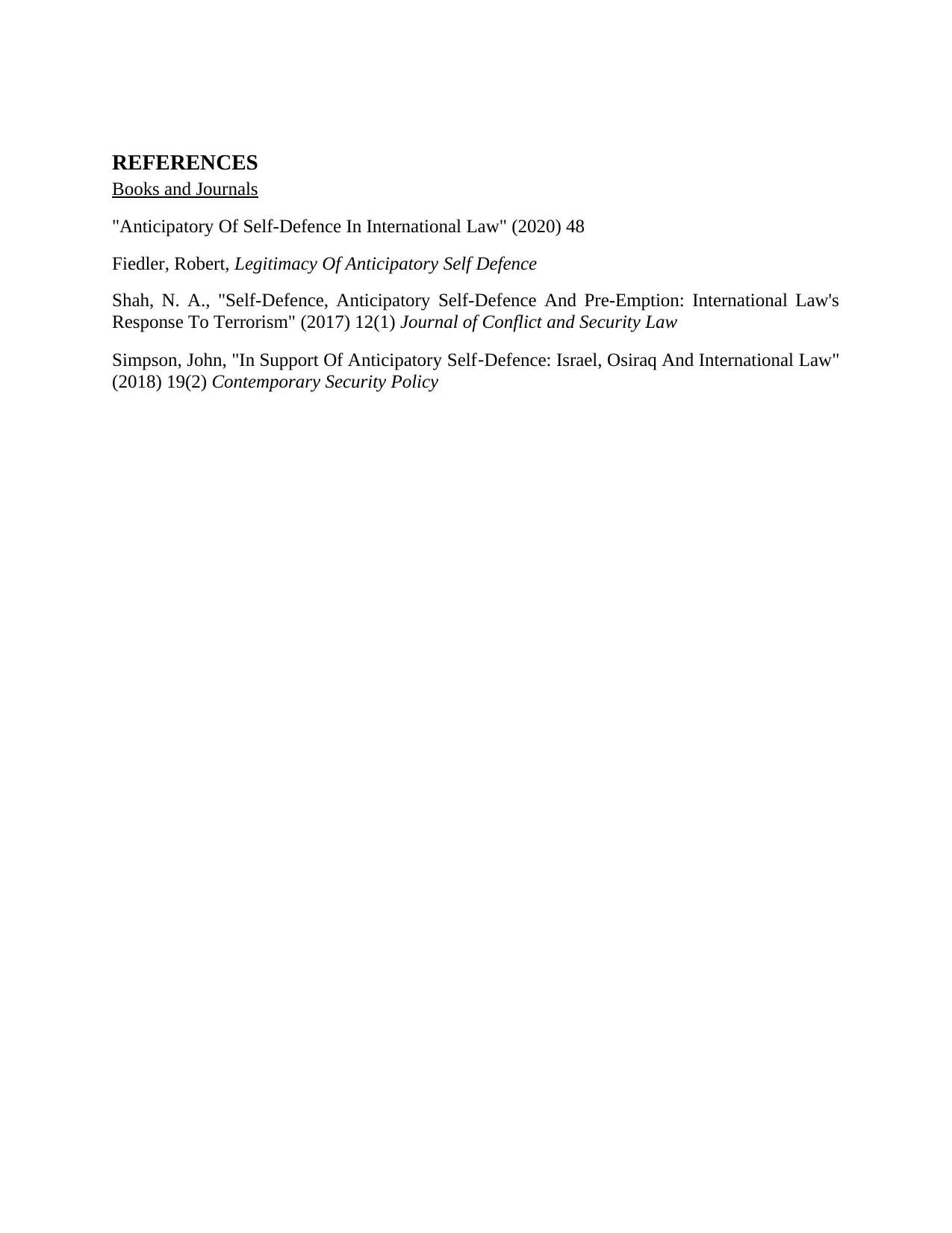
REFERENCES
Books and Journals
"Anticipatory Of Self-Defence In International Law" (2020) 48
Fiedler, Robert, Legitimacy Of Anticipatory Self Defence
Shah, N. A., "Self-Defence, Anticipatory Self-Defence And Pre-Emption: International Law's
Response To Terrorism" (2017) 12(1) Journal of Conflict and Security Law
Simpson, John, "In Support Of Anticipatory Self‐Defence: Israel, Osiraq And International Law"
(2018) 19(2) Contemporary Security Policy
Books and Journals
"Anticipatory Of Self-Defence In International Law" (2020) 48
Fiedler, Robert, Legitimacy Of Anticipatory Self Defence
Shah, N. A., "Self-Defence, Anticipatory Self-Defence And Pre-Emption: International Law's
Response To Terrorism" (2017) 12(1) Journal of Conflict and Security Law
Simpson, John, "In Support Of Anticipatory Self‐Defence: Israel, Osiraq And International Law"
(2018) 19(2) Contemporary Security Policy
⊘ This is a preview!⊘
Do you want full access?
Subscribe today to unlock all pages.

Trusted by 1+ million students worldwide
1 out of 6
Related Documents
Your All-in-One AI-Powered Toolkit for Academic Success.
+13062052269
info@desklib.com
Available 24*7 on WhatsApp / Email
![[object Object]](/_next/static/media/star-bottom.7253800d.svg)
Unlock your academic potential
Copyright © 2020–2025 A2Z Services. All Rights Reserved. Developed and managed by ZUCOL.





